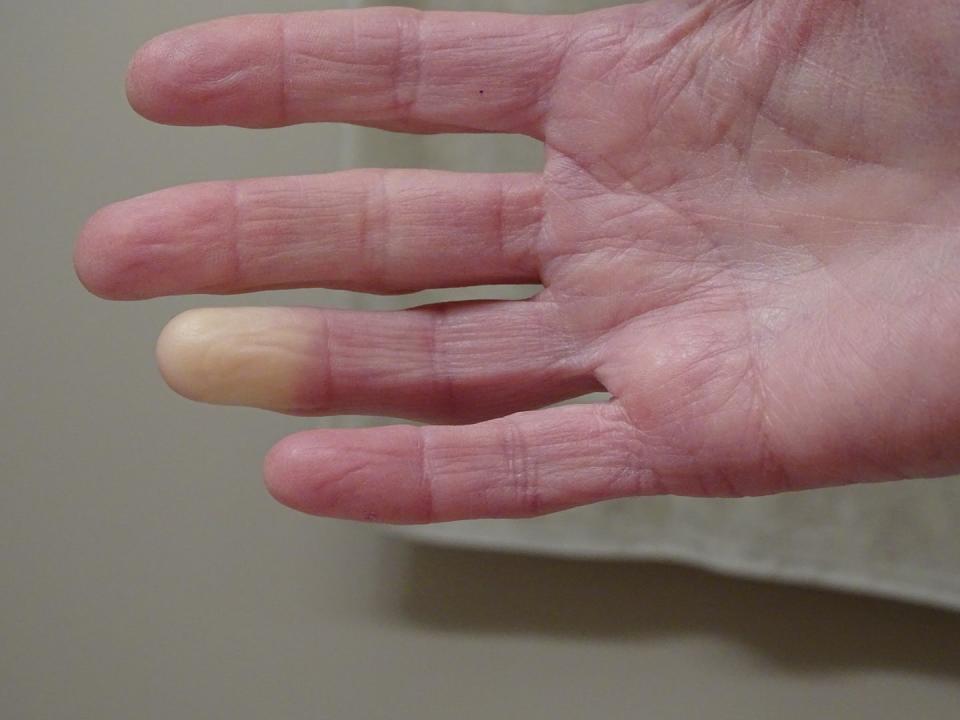How to prevent a Raynaud's attack

If your fingers go deathly pale in the cold and suddenly start to throb with pain or even lose all sensation, you might suffer from Raynaud's phenomenon. Cold weather is unpleasant at the best of times, but a drop in temperature can make Raynaud's particularly challenging.
But what is Raynaud's phenomenon and more importantly, how can you stop it from happening? We speak to family GP Dr Roger Henderson about how to manage and prevent Raynaud's phenomenon:
What is Raynaud's phenomenon?
Raynaud's phenomenon (also known as Raynaud's syndrome) is a disorder that affects your blood circulation and mainly targets your fingers and toes. It comes on when you're cold, anxious or stressed and tends to occur during the winter months. There are two main types of Raynaud's phenomenon:
• Primary Raynaud's
Primary Raynaud's happens without an obvious cause or reason.
• Secondary Raynaud's
Secondary Raynaud's is usually linked to another health problem.
Vibration white finger (VWF), also known as hand-arm vibration syndrome (HAVS), is a secondary form of Raynaud's syndrome, triggered by continuous use of vibrating hand-held machinery such as pneumatic drills and power tools, usually in an industrial environment.
⚠️ If you suffer from Raynaud's syndrome, vibrations can trigger a similar Raynaud's attack, for example riding a motorbike or moped in cold conditions.
Raynaud's phenomenon symptoms
Raynaud's essentially causes the blood vessels to narrow in response to external triggers including stress and cold temperatures, causing your extremities to go numb and lose colour, as if all of the blood has drained from your digits.
It can impact one or more fingers and tends to be extremely painful. The symptoms can also include numbness, pins and needles, white bloodless fingers or toes and difficulty moving your extremities.
Raynaud's symptoms typically include the following, as outlined by Dr Henderson:
The body saves heat when it is cold by slowing the supply of blood to the skin. It does this by making blood vessels constrict.
However, in Raynaud's phenomenon, the body's reaction to cold or stress is stronger than normal.
This means that the blood vessels narrow faster and tighter than normal. This is called an 'attack' of Raynaud's.
During such an attack, the fingers and toes can change colour, going from white to blue to red, and may also feel cold and numb from lack of blood flow.
As the attack ends and blood flows back to normal, the affected parts of the body can throb, tingle or be very painful.
After the cold parts of the body warm up, normal blood flow returns in about 15 minutes.

Raynaud's phenomenon causes
People of all ages can suffer from Raynaud's. 'It may run in families, but the primary form is the most common type, typically starting between the ages of 15 and 25,' says Dr Henderson. 'It is most common in women and people living in cold places or working in cold environments.'
'Secondary Raynaud's tends to start after the age of 35-40, and is most common in people with connective tissue diseases, such as scleroderma, Sjögren's syndrome and lupus,' he adds.
'Other possible causes include carpal tunnel syndrome, which affects nerves in the wrists. Some medications used to treat high blood pressure, migraine or cancer can also lead to secondary Raynaud's disease. People working in certain jobs may also be more likely to experience secondary Raynaud's, eg people who use tools that vibrate, such as a jackhammer.'
How do I know it's Raynaud's syndrome?
If you suffer from Raynaud's syndrome, you will have a stronger reaction to the cold or stress and your blood vessels will likely narrow much faster and tighter than normal.
'This is called an 'attack' of Raynaud's,' says Dr Henderson. 'During such an attack, the fingers and toes can change colour, going from white to blue to red, and may also feel cold and numb from lack of blood flow. As the attack ends and blood flows back to normal, the affected parts of the body can throb, tingle or be very painful.'
After the cold parts of your body warm up, normal blood flow usually returns in about 15 minutes.
How is Raynaud's diagnosed?
Diagnosis is usually done from your history of symptoms, as it's difficult to visit the doctor during an attack.
'However, it is often trickier to find out whether a person has the primary or the secondary form of the disorder,' says Dr Henderson.
'Diagnosing the different types includes taking a complete history, a detailed physical examination, performing tests (including blood tests) and looking at fingernail tissue with a microscope.'
Raynaud's phenomenon treatment
The treatment of Raynaud's aims to reduce the number of attacks occurring, making them less severe, preventing tissue damage and stopping the loss of any tissues of the fingers and toes.
'Primary Raynaud's phenomenon does not lead to tissue damage, so non-drug treatment is used first here, whereas treatment with medication is more common with secondary Raynaud's,' says Dr Henderson.
'Drug treatment typically involves blood pressure medicines or medicines that relax blood vessels, such as nifedipine.
'Pregnant women should not take these medicines. Bear in mind, however, that sometimes Raynaud's phenomenon gets better or goes away when a woman is pregnant.'
How to prevent a Raynaud's attack
To minimise the chances of a Raynaud's attack, try the following:
✔️ Maintaining a healthy lifestyle can prevent attacks.
✔️ Keep your hands and feet warm and dry.
✔️ Warm your hands and feet with warm water.
✔️ Avoid air conditioning.
✔️ Wear gloves to touch frozen or cold foods.
✔️ Wear multiple layers of loose clothing and a hat when it's cold.
✔️ Don't smoke - smoking narrows blood vessels even further.
✔️ Exercise regularly to boost blood flow.
✔️ Use chemical warmers, such as small heating pouches that can be placed in pockets, gloves, boots or shoes.
⚠️ For severe cases of Raynaud's syndrome and Vibration white finger, prescribed drugs may be used to reduce the attacks and you may be referred to a specialist for assessment. Ask your GP for advice.
Last updated: 29-10-19
You Might Also Like

